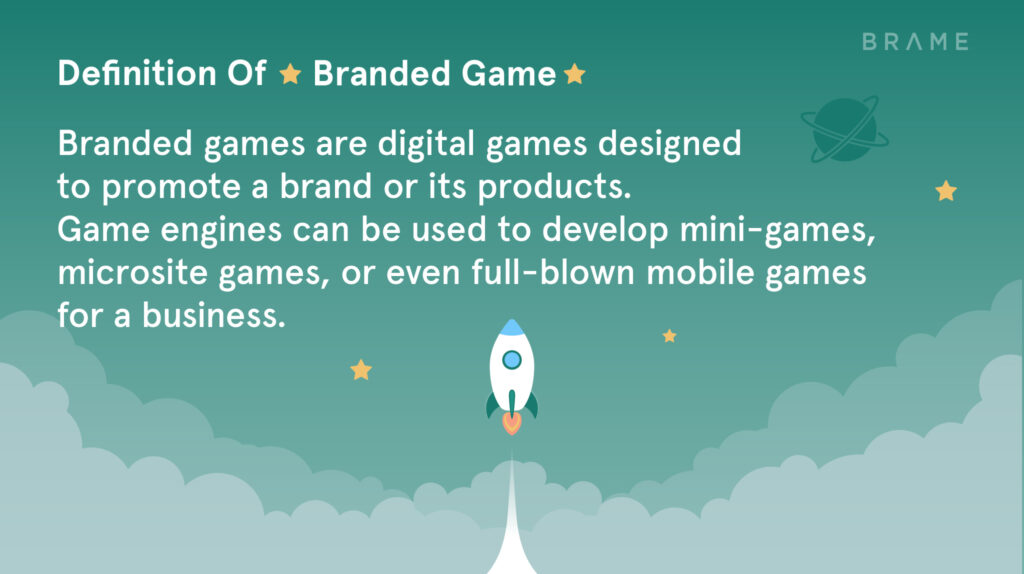Did you know that almost half of the world’s population plays video games?
There are over 3 billion gamers across the globe, according to Statista.
This means that many of your customers also enjoy playing games in their leisure time. Not to mention, the recent developments in immersive virtual worlds such as the Metaverse have begun gamifying everyday life.
As businesses continue to explore creative ways to engage customers and improve brand visibility, branded games have emerged as an effective marketing tool.
What if your business offered customers fun and entertaining online gaming experiences while delivering important marketing messages?
Branded games refer to digital games designed to promote a brand or its products.
These branded marketing games are a fresh and innovative way to grow your business. They provide immersive experiences that engage users and promote customer loyalty.
With the rise of mobile devices, online games have become increasingly popular. This makes them an ideal tool for reaching a wider audience. You can use game engines to develop mini-games, microsite games, or even full-blown mobile games for your business.

Brame offers a no-code platform for you to create unique and compelling embeddable branded games that will keep your target customers coming back for more.
79% of Gen Alpha and Gen Z gamers play on mobile and 56% of Millennials are active PC game players, according to Finances Online.
In this article, we will explore:
- Seven steps to create a branded game
- Four ways to improve your branded gaming experiences
Let us look at how businesses can design and launch custom-branded games for their marketing campaigns.
1. Set Clear Game Objectives
At the planning stage of your game design, you need to establish the specific goals and business objectives that you want to achieve.
Determine Game Objectives With The Following Questions:
- Do you want to increase brand awareness and encourage customer loyalty?
- Are you launching a new product or generating sales leads (lead gen)?
- Do you want to increase revenue?
If your aims lean more towards increasing brand awareness and creating loyal customers, your game should focus on your customer experience and help them build an emotional connection with your brand.
If promoting a new product launch or lead gen is your main objective, your game should have an educational aspect. It should also garner customer information so you can populate your CRM (Customer Relationship Management) platform and follow up with new sales leads.
For increasing revenue, your game can include prizes and discount coupons that customers can redeem at your store.
Clarifying these objectives will help guide the development process by ensuring that your game aligns with your marketing goals.
Starting with your business objectives enables you to create a game that meets its purpose, engages users, and provides value to them.
2. Create A Compelling Game
A successful branded game should be engaging and enjoyable enough for users to keep coming back. It should not be too sales-orientated or ask the customer to do too much “work.”
Games can be intrinsically or extrinsically rewarding. Intrinsic rewards have to do with the customers’ personal goals and game experience. They may play the game to reach a high score, gain social status, or simply for their own enjoyment.
Extrinsic rewards have real-world value, such as cash prizes, membership benefits, discount codes, products, and experiences. These kinds of rewards are highly motivating and customers will participate in a game to win them.
Choosing the right type of game is critical as it will determine the user engagement level. An ideal formula involves combining elements related to your business or brand with popular game features.
Your Game Concept should align both with your brand and target audience. For example, if your business is a clothing store promoting active wear to football fans, then a football-themed game would immediately draw their attention.
You can build a Swipe or Quiz game asking football-related questions or a Guess The Picture game that uses images of famous football players. If you want to bring in an element of luck, create a Spin The Wheel or Scratch Card game where customers can win instant prizes.
Pay careful attention to intellectual property rights when using third-party images in your games.
Add form fields to capture a new customer’s name and email address, at the bare minimum. Having a name and email address will enable you to add them to your email list and send personalized messages.
You can also add more form fields depending on the information you need. For example, if the customer has won a t-shirt, you need to ask about their shirt size and delivery address.
3. Integrate Your Brand Elements
To make the most out of branded games for business marketing, incorporating brand elements into the gameplay is crucial.
Add your logo, brand colors, and other brand elements like your slogan or campaign taglines to enhance the user experience and help customers identify your brand.
If you are not sure where to find these brand assets and hex color codes, contact someone from your company’s graphic design team. They should be able to send the images and colors you need in the correct formats.
Consider collaborating with someone from your design team on your branded game project, as it is imperative that you use only high-quality images that follow your brand guidelines.
4. Add Social Sharing Features
One of the ways to add more intrinsic motivators to your game is to create opportunities for social sharing. People enjoy connecting with others and receiving recognition and praise.
Adding social features, such as allowing players to share their high scores on social media platforms, can expand the reach of your branded game beyond existing customers. User-generated content (UGC) is an excellent driver for attracting new customers.
Social sharing builds a positive reputation for your brand on the other platforms your customers engage with. It can also drive more traffic to your branded game and help generate more leads from your campaign.
5. Provide Incentives
Earlier in this post, we mentioned that prizes play an important role in motivating customers to engage with branded games.
Incentives are useful tools for boosting user engagement at various stages of gameplay.
Offering rewards like coupons, discounts, or even exclusive content provides additional motivation for players to continue interacting with your brand throughout the campaign.
Allowing customers to play the game multiple times to increase their chances of winning is also a proven strategy for increasing customer engagement.
Enable every customer to win at least once, no matter how small the prize. Otherwise, customers may give up playing the game and engaging with the campaign altogether.
With Brame, you can set the winning parameters using our prize management feature.
6. Promote Your Game
Once you have created a compelling branded game and added various game elements and incentives, it is time to put it in front of your target audience. After publishing your game, promoting it becomes crucial to ensure that it engages your customers.
Look at the available online channels and decide which ones will reach your Ideal Customer Persona (ICP). These could include email lists, social media pages, online ads, and influencer partnerships. You can also consider traditional advertising platforms such as print publications, business events, and billboards.
Using branded games for business development has provided massive success for companies in retail, financial services, food and beverages, and more industries.
T&G, a food wholesaler, celebrated its twenty-fifth anniversary by rewarding its loyal customers with prizes. Their team created a Spin The Wheel game using Brame.
The company saw more than 84,000 game visits, with a 90% completion rate and 43% newsletter conversions.
Branded games provide exciting opportunities for increased customer engagement while highlighting your brand in a non-intrusive and entertaining way.
7. Track Metrics And Results
An often-overlooked step in the gamification process is to track and analyze metrics such as visits, active users, downloads, and clickthrough rate (CTR).
These metrics help to measure the success of campaigns by analyzing data insights in real-time. You can also use these results to make mid-campaign tweaks, such as changing the calls to action (CTAs), images, or game elements.
Track any changes in website traffic following the launch of your branded game to see if you have attracted new website visitors. You can also check which search terms new visitors used to find your website.
If you have integrated with your CRM platform, you will see the new sales leads your campaign generated.

Four Ways To Improve Your Branded Games
We have found a few strategies that ensure branded games perform optimally. Improving your branded games requires flexibility and problem-solving. You also need to keep in contact with your customers to provide them with the most value.
1. Make Changes
If your branded game does not deliver remarkable results at first, try and find out what did not work. Look for visitor drop-offs or form incompletions in your metrics and try to adapt your game for better performance.
For example, you may notice that customers play the game but abandon the page once they reach the form at the end. This means you cannot capture their details to add to your CRM or newsletter audience.
Consider Making One Of The Following Changes:
- Use fewer form fields
- Write a compelling CTA
- Change the color of the CTA button
- Incentivize customers with rewards, such as a free product, voucher, or discount
- Ask for the customer’s name and email address at the start of the game
2. Get Customer Feedback
Did customers enjoy your gaming experience? Ask them if they have any suggestions or questions that will help you improve it.
People are often more motivated to give feedback if they have had a negative or frustrating experience.
It is not always pleasant to hear as a business owner, but critical feedback from a handful of customers can help you improve the experience of thousands of others.
You can also offer a reward or compensation in return for their feedback. This may increase the likelihood of your customers giving feedback and will show them that you value their input.
If a customer had a negative or frustrating experience, a small reward will leave them with a more positive feeling.
3. Follow Through
If your game includes a giveaway, discount code, or newsletter signup, it is imperative that you follow through with these.
Ensure that every customer receives their prizes or coupons. Check that all discount codes are valid and distributed correctly. If they signed up for a newsletter or other updates, send confirmation emails and track their open rates.
Keeping the communication lines open once your customers have interacted with the company through your branded game is crucial.
Follow through with every question and suggestion that you receive on your customer feedback form. Show your customers that your business is truly interactive and customer-centric.
4. Experiment
There are a wide collection of game options when building your branded game. We recommend trying different Game Concepts and comparing the results.
If you are hosting your branded game on your website, you can also use A/B testing to deliver different games to different customers. This will help you measure different responses in your target audience. You can use these insights to choose the winning game concept to take your campaign further.
Try The Following Game Experiments:
- Can you get a higher completion rate with a different game type?
- Are instant games better than ones that take longer to complete?
- Are action-based games better than text-based ones?
- Can you get better results with a few design changes, such as changing the in-game images?
- Is a mini-game embedded on your website more effective than a microsite game hosted on its own domain?
These experiments will help you find winning game concepts for your campaign.
Your Next Steps
Using branded games as part of your marketing strategy is an innovative approach that delivers a return on investment (ROI).
Today, consumers are wary of advertising messages. Marketing gamification offers value to customers while promoting your business objectives in a non-intrusive way. By keeping these tips in mind when creating your branded game, you will see measurable business growth.
Brame is a marketing gamification platform that empowers you to create customized branded games that leverage proven gaming principles.
Our browser-based games are desktop- and mobile-friendly. They enable you to drive traffic to your company’s website and count clicks, scroll, and other visitor behaviors.
Make your own no-code branded game today.
Request A Demo






